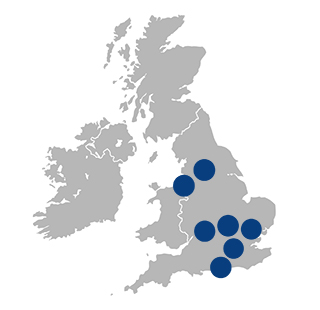
Written by:

Medically Reviewed by:
Last Updated:
February 17th, 2025
Ritalin Rehab
There are more people than ever taking ADHD medicine in the UK, including record-high numbers of Ritalin prescriptions. While Ritalin is an effective medication, people sometimes start taking too much Ritalin or use it when they don’t really need to. This can lead to serious problems including drug addiction. Ritalin addiction can be a dangerous and even fatal condition so getting treatment as soon as possible could save your life. Liberty House’s Ritalin rehab programmes have guided many people to happier, healthier lives and break their reliance on Ritalin.
What is Ritalin rehab?
Ritalin rehab is a type of treatment that helps addicted people stop using Ritalin and learn how to live without it. The process has three steps:
- Drug detox for physical dependence
- Drug rehab therapy for mental and emotional dependence
- Aftercare to stop you from relapsing after you leave
Liberty House is a residential Ritalin rehab centre, which means you will stay with us while you complete the first two stages. How long this takes depends on the severity of your dependency and how well you respond to Ritalin rehab so we offer stays ranging from a couple of weeks all the way up to three months.
Here is what you will experience during your stay:
1. Ritalin detox
With prolonged, high-dose Ritalin use, your brain gets so used to the drug that it feels off without it. Stopping Ritalin suddenly can then make your body and mind push back hard. This is called withdrawal and you have probably had a glimpse of it if you’ve ever tried to quit at home.
Medical Ritalin detox reduces the risk and discomfort of withdrawal. At Liberty House, we have experts who can oversee the detox process efficiently and safely. This is very important because different people need different levels of support.
Some people need medications to ease certain Ritalin withdrawal symptoms, while others find rest; plenty of fluids and emotional support are enough. Whatever you need, Liberty House will make sure you’re taken care of safely.
Ritalin withdrawal symptoms and timeline
In the first 24 to 48 hours, your body realises it’s not getting the drug anymore, but it takes a bit of time to recalibrate. You might feel like all your energy has been drained and it can be hard to think clearly or move around much.
Around day three to five, the toughest Ritalin withdrawal symptoms usually appear. This is when emotions often swing the most, sleep becomes increasingly elusive and you begin to crave Ritalin more intensely.
By the end of the first week, most people start noticing small improvements, such as their energy returning and their cravings gradually dull. However, some things, like restless nights or feeling on edge, might hang around for a few more weeks but this is totally normal.
Here are some common Ritalin withdrawal symptoms to watch for:
- Feeling completely drained, like your battery is running low.
- Feeling hungrier than usual as Ritalin’s appetite suppression ends.
- Either getting too much sleep or not enough.
- Strong cravings for Ritalin at all hours of the day.
- Big emotions, like sadness or irritability, bubbling to the surface.
While rare, some Ritalin withdrawal symptoms need extra care, but our team at Liberty House will observe you, so they are ready to step in and keep you safe. These symptoms might include:
- Feeling deeply sad or having thoughts about hurting yourself.
- Hearing or seeing things that aren’t really there.
- Feeling overly suspicious or getting upset easily.
- Heart issues or even seizures (though these are extremely uncommon).
2. Ritalin rehab therapy
Ritalin rehab therapy will allow you to dig into what led you here and figure out what’s keeping you stuck. It is not about pointing fingers or making you feel bad about yourself; it is about having a real conversation with trained therapists, in which you can talk openly about what’s going on.
Maybe Ritalin started as something small—a way to keep up with work or school—but somewhere along the way, it got harder to control. Ritalin rehab helps you explore that shift and what might’ve triggered it.
Crucially, the Ritalin rehab process is not about quick fixes. Think of it as a journey where each mile brings new lessons and insights into why things happened and what you can do differently moving forward. As you move along the path, you will start making connections, gaining clarity and creating new habits that don’t involve Ritalin.
Ritalin rehab therapy at Liberty House Clinic
Life with Ritalin addiction can feel like everything’s out of control so Liberty House has created a routine that brings balance back. Every day is carefully planned to keep your mind engaged and your energy focused on healing. You will spend your time engaged in traditional therapy sessions as well as activities that let you relax or get creative.
Just some of the techniques you will take part in include:
- Individual and group therapy
- Family support sessions
- Conjoints for
- Holistic therapies like yoga, meditation and physical health therapy
- Various forms of behavioural therapy and psychotherapy
- Daily walks and other holistic activities
With so many choices, our clients always find something that helps. Sometimes, the unexpected things end up sparking the most change, so being open to new ideas is crucial for successful recovery.
3. Post-rehab planning and aftercare
When your time at Liberty House comes to an end, you may be worried about leaving the sanctuary of stimulant rehab. We know how scary the transition can be but we have vast experience in helping our clients get ready for life after treatment. That is why phase three of Ritalin rehab is to make the move back home as smooth as possible, without too many bumps along the way.
While you are with us, we will help you draw up your own Ritalin relapse prevention plan. This personalised plan is like a 24/7 guide, helping you steer clear of things that might tempt you back into old habits. These may be meeting people who you used to take drugs with, going back to a stressful job, or just resuming your old responsibilities. Your plan will lay out how to face these challenges using all the skills and knowledge you gained in Ritalin rehab.
But we don’t just give you a plan and say good luck – every week for a whole year, we invite you back for free group therapy. This is like a recovery check-in – a chance to chat about what’s working, vent about what’s not and pick up fresh advice when you need it most.
You will be granted lifetime membership to UKAT’s exclusive Alumni Network. This is where you connect with other folks who have been through it. There are regular meet-ups and events, and even some fun is thrown in!
Begin Ritalin rehab today
Life after Ritalin awaits you, and Liberty House is here to help you find it. With expert support and people who understand what you’re going through, you will have everything you need to make a lasting transformation. Reach out to us today and take charge of your own recovery.





